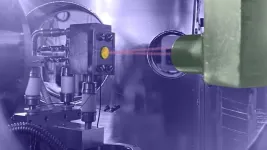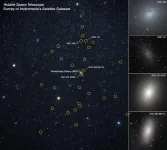The quantum rules shaping molecular collisions are now coming into focus, offering fresh insights for chemistry and materials science.
When molecules collide with surfaces, a complex exchange of energy takes place between the molecule and the atoms composing the surface. But beneath this dizzying complexity, quantum mechanics, which celebrates its 100th anniversary this year, governs the process.
Quantum interference, in particular, plays a key role. It occurs when different pathways that a molecule can take overlap, resulting in specific patterns of interaction: some pathways amplify each other, while others cancel out entirely. This “dance of waves” affects how molecules exchange energy and momentum with surfaces, and ultimately how efficiently they react.
But until now, observing quantum interference in surface collisions with heavier molecules like methane (CH4) was nearly impossible because of the overwhelming number of pathways available for the system to take en route to the different collision outcomes. Many scientists have even wondered if all quantum effects would always “wash out” for these processes so that the simpler laws of classical physics, which apply to everyday, “macroscopic” objects, might be enough to describe them.
Addressing the challenge of observing quantum interference in surface collisions of methane, researchers in Rainer Beck’s group at EPFL, with colleagues in Germany and the United States, have developed a method to cut through the complexity. They tuned methane molecules to specific quantum states, scattered them off a gold (Au) surface, and measured their states after the collision.
The results, published in Science, revealed clear patterns of quantum interference, challenging assumptions about molecular behavior and providing new ways to study these interactions.
Gold rush
The team didn’t use just any chunk of gold to serve as a scattering surface;they used a gold sample carefully grown to be perfectly crystalline and then cut along a special direction to reveal a surface named “Au(111)”, which is atomically smooth and chemically inert. They also kept the surface under ultra-high vacuum during experiments to prevent contamination from gas particles present under normal ambient conditions.
The exceptional flatness and cleanliness of the Au(111) surface ensured that the observed scattering behavior arose from fundamental quantum wave aspects rather than random surface irregularities or impurities, allowing the team to focus purely on interference effects.
Laser focus
The researchers then used a laser-based technique to precisely control the quantum states of methane molecules before they collided with the gold surface and measure the quantum states the molecules occupy after the collision. Methane molecules naturally exist in a mix of different energy states, meaning their internal vibrations and rotations vary. So to make sure all the molecules started in the same well-defined quantum state, the researchers first fired a pump laser at a beam of methane molecules, exciting them into a well-defined quantum state.
They then aimed the beam of methane molecules at a pristine Au(111) surface, where they collided and scattered. After the collision, the team hit the scattered molecules with a tagging laser tuned to specific energy levels. If a molecule was in a matching quantum state, it absorbed the laser’s energy, creating a tiny change in temperature of the scattering molecules that the researchers could measure with a highly sensitive detector called a bolometer.
Quantum interference revealed
The scientists used this method to figure out which quantum states the methane molecules occupied after colliding with the gold surface. When they compared their results to quantum theory, they found that symmetry dictated which transitions were allowed and which were forbidden.
In simple terms, symmetry describes how something stays the same when flipped, rotated, or reflected. In the quantum world, every state of a molecule has a specific symmetry, and transitions between states must follow strict symmetry rules.
If two states of a methane molecule had incompatible symmetry, then the different pathways taken between these two states canceled out one another. In this case the transition simply did not happen—like trying to walk through a doorway that leads to a brick wall. But when the states had compatible symmetry, the pathways amplified one another and the transitions were strong and clearly visible—like doors aligning between rooms, allowing smooth movement. This confirmed that quantum interference isn’t just an abstract concept but actively controls molecular behavior at surfaces.
The double-slit connection
In their paper, the authors draw an elegant analogy to the famous double-slit experiment, where particles like electrons produce interference patterns when passed through two slits, behaving like waves, just as methane molecules displayed interference here (see image).
Specifically, the study uncovers a new form of quantum interference in molecule scattering. Unlike the more familiar “diffractive” interference that affects scattering angles (as in the double-slit experiment), interference here affected the methane molecules’ rotational and vibrational states, suppressing some transitions while enhancing others.
The research showcases — 100 years after the advent of quantum mechanics — one of the clearest examples of quantum wave effects in molecule-surface interactions, paving the way for advancements in surface chemistry, cleaner energy catalysts, and efficient industrial processes. They also provide a new framework for exploring molecular interactions in both fundamental and applied sciences.
Other contributors
Max Planck Institute for Multidisciplinary Sciences
University of New Mexico
Reference
Reilly, C. S., Auerbach, D. J., Zhang, L., Guo, H., & Beck, R. D. (2025). Quantum interference observed in state-resolved molecule-surface scattering. Science 28 February 2025. DOI: 10.1126/science.adu1023
END







